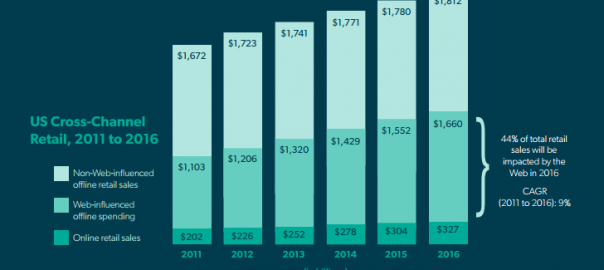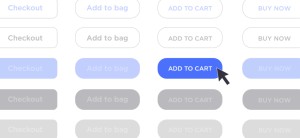Consumers are shopping across numerous channels, including digital, mobile and physical locations. With the ever-increasing focus on omnichannel strategies to stay competitive, retailers must continually keep up with the changing online landscape to maintain their competitive edge. Although fierce competition won’t get any easier, plenty of opportunities exist for retailers to capture new market share with strategies that embrace multiple channels and cross-device shopping. On the other hand, retailers who don’t fully commit risk losing market share to those brands who are keeping abreast of this change.
Shoppers who interact with more than one channel spend 18% to 36% more than those who interact with a single channel. Here are 5 important strategies that retailers must implement to take advantage of these opportunities and capture new mindshare, market share, and customer loyalty.
Get Hyper-Focused on Your Online Game
As we know, ecommerce spend is skyrocketing and will continue to do so for some time. E-commerce is expected to hit $ 327 billion by 2016, up from $ 202 billion in 2011 (bazaarvoice).

Simply have an online presence with content and promotions scattered across popular digital channels is no longer enough. Consumers research, look for recommendations, and compare prices on different channels depending on where they are at in the purchase cycle. They may start with a google search to find brands that offer the products they are interesting in purchasing, check out your social media sites to look at customer reviews, visit your website to check out your inventory, and perhaps save some items to a cart while they continue to other sites looking at online reviews again. Each path to purchase is different but each plays an important role in the overall journey.
Your online presence must be super-focused and highly visible across multiple digital channels. 70% of consumers research online before purchasing in-store, and the average shopper uses approximately 10.4 sources of information to make a purchase decision (bazaarvoice). With consumers fragmented across channels, be sure to focus on areas such as SEO, social media channel diversification, active encouragement of online reviews on multiple sites, and sharing of plenty of content such as videos, pictures, contests, and promotions. As consumers are researching and discovering products, services and brands, a strong and diverse online channel has never been more crucial.
Move Beyond Traditional Tool Sets with New Technologies and Analytics
Technology is constantly evolving, providing new platforms and solutions to help retailers more easily implement the experiences and seamless cross-channel journeys consumers expect. Today’s marketers are increasingly in charge of technology spend and solutions, so it may be time to take inventory and determine which solutions can add value and enhance the efficiency of your operations.

The top three technologies in which marketers are currently investing to boost omnichannel engagement include marketing analytics, data targeting and segmentation, and marketing automation. Among all marketers, 63% say that they’ll increase expenditure on tools and technology in the next two years (Source: State of Marketing report published annually by Salesforce).

Integrate Data Across Channels for a Singular Customer View
Consumers view a brand as a single entity, not as various channels within the brand. We have heard time and again about the necessity of providing consumers with seamless customer experiences, whether a consumer is interacting with you on email, social, customer service, or at the store. Each engagement produces a wealth of data regarding a consumer’s likes, dislikes, likely next purchases, channel preferences, and so forth. However, when each channel is operated as a separate entity, customer information cannot be shared between systems to create a single customer view.

Achieving this single customer view across channels has become the holy grail to driving a successful omnichannel strategy. According to research by AgilOne, without an omnichannel view you will be unable to identify 70% of your most valuable (top decile) customers.
According to the research by Salesforce, top performing marketers are actively integrating their campaigns into their overall marketing strategy. As an example, 82% of top marketers consider social media ads as a part of their mobile marketing strategy. High performing marketers have also:
- Integrated their mobile marketing strategy and data into the overall marketing strategy (60%)
- Have integrated their email marketing strategy and data into the overall marketing strategy (64%)
- Have integrated their social media strategy and data into the overall marketing strategy (63%)

Enhance Your Customer View with Analytics and the Right Data Insights
According to a recent survey by Periscope, a unit of McKinsey Solutions, retailers are struggling to move at the speed their consumers want and need. Periscope’s survey found 78% admit there is no one brand experience across their channels but acknowledge that “a well-defined cross or multi-channel strategy” is the top innovation that would drive digital growth (64%).
The report went on to state the top three reasons behind the omnichannel struggle as follows:
- Lack of customer analytics across channels (67%)
- Siloed organization (48%)
- Poor data quality (45%)
Accessing and analyzing consumer data as they move from channel to channel is, and has been, an ongoing struggle for retailers for some time. By breaking down data siloes through channel integration, consumer data can be cleansed, analyzed and enhanced with additional insights to establish truly rich consumer profiles and deep customer insight.
Get Personal in Real-Time
With consumers demanding a personalized experience across channels, marketers are getting more innovative in their real-time personalization efforts. According to a report by eMarketer, “April 2015 polling by Researchscape for Evergage found that 58% of marketers worldwide used real-time personalization—defined as data-driven personalization completed in less than 1 second. Among the 42% not using it, nearly eight in 10 intended to do so within the next year.”
Almost half (44%) of marketers are focusing their real-time personalization efforts on their websites. The payoff for real-time personalization is well worth the effort with 40% of consumers spending more due to a personalized website experience. The types of personalization marketers are using in their websites include:
- 53% – Pop-up messages
- 53% – inline content (text or images inserted dynamically within the page content)
- 43% – Information bars (messages across the top or bottom of the web page)

Email is another powerful channel on which retailers are focusing time to integrate and personalize. Marketers also rate email is one of the top channels for producing ROI. In fact, over 75% of email revenue is generated by personalized triggered campaigns, rather than one-size-fits-all campaigns (DMA).

Consumers know what types of shopping experiences they want as they shop on their own terms, through the channels they prefer and at the location they desire. Retailers must cater to today’s consumers with relevant and personalized messaging and seamless customer journeys. Retailers that embrace an omnichannel mindset will find loyal brand advocates who will be more engaged, spend more and who will deliver word of their positive experience with your brand.
Business & Finance Articles on Business 2 Community
(56)










